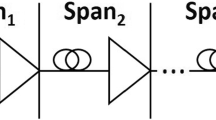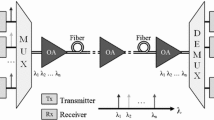Abstract
Greater demand of bandwidth and network usage flexibility from customers along with new automated means for network resource management has led to the concept of dynamic resource provisioning in WDM optical networks where unlike the traditional static channel assignment process, network resources can be assigned dynamically. This paper examines a novel particle swarm optimization (PSO)-based scheme to solve dynamic routing and wavelength assignment (dynamic RWA) process needed to provision optical channels for wavelength continuous Wavelength Division Multiplexed (WDM) optical network without any wavelength conversion capability. The proposed PSO scheme employs a novel fitness function which is used during quantization of solutions represented by respective particles of the swarm. The proposed fitness function takes into account the normalized path length of the chosen route and the normalized number of free wavelengths available over the whole route, enabling the PSO-based scheme to be self-tuning by minimizing the need to have a dynamic algorithmic parameter ‘α’ needed for better performance in terms of blocking probability of the connection requests. Simulation results show better performance of the proposed PSO scheme employing novel fitness function for solving dynamic RWA problem, not only in terms of connection blocking probability but also route computation time as compared to other evolutionary schemes like genetic algorithms.
Similar content being viewed by others
References
Bisbal D et al (2004) Dynamic routing and wavelength assignment in optical networks by means of genetic algorithms. Photonic Netw Commun 7(1): 43–58
Boeringer DW, Werner DH (2004) Particle swarm optimization versus genetic algorithms for phased array synthesis. IEEE Trans Antenn Propag 52(3): 771–779
Chlamtac I, Ganz A, Karmi G (1992) Lightpath communications: an approach to high-bandwidth optical WAN’s. IEEE Trans Commun 40(7): 1171–1182
Clerc M (1999) The swarm and queen: towards a deterministic and adaptive particle swarm optimization. In: Proceedings of the congress on evolutionary computation (CEC ‘99), vol 3. Washington, DC, USA, pp 1951–1957
Eberhart RC, Kennedy J (1995) A new optimizer using particle swarm theory. In: Proceedings of the sixth international symposium on micromachine and human science, Nagoya, Japan, pp 39–43
Eberhart RC, Shi Y (1998) Comparison between genetic algorithms and particle swarm optimization. In: Proceedings of the 7th international conference on evolutionary programming, Springer, San Diego, CA, USA, pp 611–616
Elbeltagi E, Hegazy T, Grierson D (2005) Comparison among five evolutionary-based optimization algorithms. Adv Eng Inform 19(1): 43–53
Gen M, Cheng R, Wang D (1997) Genetic algorithms for solving shortest path problems. In: Proceedings of the IEEE international conference on evolutionary computation, Indianapolis, IN, USA, pp 401–406
Hassan R, Cohanim B, DeWeck OL, Venter G (2005) A comparison of particle swarm optimization and the genetic algorithm. In: Proceedings of the 1st AIAA multidisciplinary design optimization specialist conference, Austin, TX, USA
Iqbal M, Freitas AA, Johnson CG (2005) Varying the topology and probability of reinitialization in particle swarm optimization. In: Proceedings of the 7th international conference on artificial evolution, Lille, France
Kennedy J, Eberhart RC (1995) Particle swarm optimization. In: Proceedings IEEE international conference on neural networks,IV, IEEE Service Center, Piscataway, NJ, pp 1942–1948
Le VT et al (2004) A genetic algorithm for dynamic routing and wavelength assignment in WDM networks, vol 3358. Springer, Berlin, Heidelberg, pp 1611–3349, ISSN 0302-9743 (Print), ISBN 978-3-540-24128-7, doi:10.1007/b104574
Lu K, Xiao G, Chlamtac I (2005) Analysis of blocking probability for distributed lightpath establishment in WDM optical networks. IEEE/ACM Trans Netw 13(1): 187–197
Mohemmed AW, Sahoo NC (2007) Efficient computation of shortest paths in networks using particle swarm optimization and noising metaheuristics. Discrete Dyn Nat Soc. doi:10.1155/2007/27383
Mouser CR, Dunn SA (2005) Comparing genetic algorithms and particle swarm optimization for an inverse problem exercise. Aust NZ Ind Appl Math J 46(part C): C89–C101
Mukherjee B (1997) Optical communication networks. McGraw-Hill, New York
Munemoto M, Takai Y, Sato Y (1998) A migration scheme for the genetic adaptive routing algorithm. In: Proceedings of IEEE international conference on systems, man, and cybernetics, vol 3. San Diego, CA, USA, pp 2774–2779
Raidl G, Julstrom BA (2000) A weighted coding in a genetic algorithm for the degree constrained minimum spanning tree problem. In: Proceedings of the ACM symposium on applied computing (SAC ‘00), vol 1. Como, Italy, pp 440–445
Ramaswami R, Sivarajan KN (1995) Routing and wavelength assignment in all-optical networks. IEEE/ACM Trans Netw 3: 489–500
Shi YH, Eberhart RC (1998) A modified particle swarm optimizer. In: Proceedings of 1998 IEEE international conference on evolutionary computation, Anchorage, AK (in press)
Srinivas P, Battiti R (2006) The gregarious particle swarm optimizer (G-PSO). In: Proceedings of the 8th annual conference genetic and evolutionary computation (GECCO ‘06), Seattle, WA, USA, pp 67–74
Xie X-F, Zang W-J, Yang Z-L (2002) Dissipative particle swarm optimization. In: Proceedings of the congress on evolutionary computation (CEC ‘02), vol 2. Honolulu, Hawaii, USA, pp 1456–1461
Zang H et al (2000) A review of routing and wavelength assignment approaches for wavelength-routed optical WDM networks. Opt Netw Mag 1(1): 47–60
Author information
Authors and Affiliations
Corresponding author
Rights and permissions
About this article
Cite this article
Hassan, A., Phillips, C. Particle swarm optimization-based DRWA for wavelength continuous WDM optical networks using a novel fitness function. Artif Intell Rev 29, 305 (2008). https://doi.org/10.1007/s10462-009-9142-5
Published:
DOI: https://doi.org/10.1007/s10462-009-9142-5




